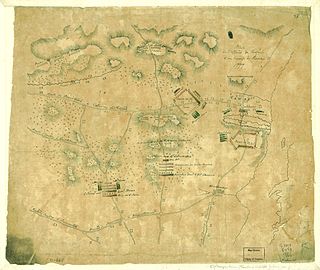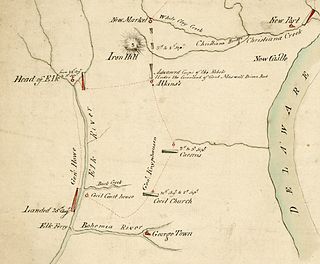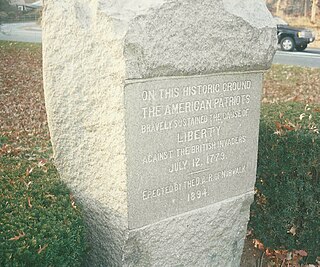Related Research Articles

The Battle of Bennington was a battle of the American Revolutionary War, part of the Saratoga campaign, that took place on August 16, 1777, on a farm in Walloomsac, New York, about 10 miles (16 km) from its namesake, Bennington, Vermont. An American force of 2,000 men, primarily New Hampshire and Massachusetts militiamen, led by General John Stark, and reinforced by Vermont militiamen led by Colonel Seth Warner and members of the Green Mountain Boys, decisively defeated a detachment of General John Burgoyne's army led by Lieutenant-Colonel Friedrich Baum, and supported by additional troops under Lieutenant-Colonel Heinrich von Breymann.

The Battle of Brandywine, also known as the Battle of Brandywine Creek, was fought between the American Continental Army of General George Washington and the British Army of General Sir William Howe on September 11, 1777, as part of the American Revolutionary War (1775–1783). The forces met near Chadds Ford, Pennsylvania. More troops fought at Brandywine than at any other battle of the American Revolution. It was also the second longest single-day battle of the war, after the Battle of Monmouth, with continuous fighting for 11 hours.

The New York and New Jersey campaign in 1776 and the winter months of 1777 was a series of American Revolutionary War battles for control of the Port of New York and the state of New Jersey, fought between British forces under General Sir William Howe and the Continental Army under General George Washington. Howe was successful in driving Washington out of New York, but overextended his reach into New Jersey, and ended the New York and New Jersey campaign in January 1777 with only a few outposts near New York City under British control. The British held New York Harbor for the rest of the Revolutionary War, using it as a base for expeditions against other targets.

The Battle of Cowpens was a military engagement during the American Revolutionary War fought on January 17, 1781, near the town of Cowpens, South Carolina. American Patriot forces, estimated at 2,000 militia and regulars under Brigadier General Daniel Morgan faced 1,000 British troops under Lieutenant Colonel Banastre Tarleton.

The Battle of Pell's Point, also known as the Battle of Pelham, was a skirmish fought between British and American troops during the New York and New Jersey campaign of the American Revolutionary War. The conflict took place in what is now part of Pelham Bay Park in the Bronx, New York City and the villages of Pelham Manor and Pelham in Westchester County, New York.

The Battle of the Assunpink Creek, also known as the Second Battle of Trenton, was a battle between American and British troops that took place in and around Trenton, New Jersey, on January 2, 1777, during the American Revolutionary War, and resulted in an American victory.

The Battle of Bound Brook was a surprise attack by British and Hessian forces on a Continental Army outpost in Bound Brook, New Jersey, during the American Revolutionary War. Although the British aimed to capture the garrison, they fell short and took some prisoners. U.S. commander Major General Benjamin Lincoln left quickly, abandoning papers and personal effects.

New Jersey played a central role in the American Revolution both politically and militarily. It was the site of more than 90 military engagements, including the pivotal battles of Trenton, Princeton, and Monmouth. George Washington led his army across the state four times and encamped there during three hard winters, enduring some of the greatest's setbacks of the war as well as seminal victories. New Jersey's decisive role in the conflict earned it the title, "Crossroads of the American Revolution".

The Baylor Massacre was an attack by British forces against Continental Army troops on September 27, 1778, during the American Revolutionary War. A force of British soldiers under the command of Major-General Charles Grey carried a successful surprise attack against the 3rd Regiment of Continental Light Dragoons under the command of Colonel George Baylor near present-day River Vale, New Jersey. 15 Continental Army soldiers were killed while a further 54 were wounded or captured by the British, who lost one soldier killed.

The Battle of Fort Washington was fought in New York on November 16, 1776, during the American Revolutionary War between the United States and Great Britain. It was a British victory that gained the surrender of the remnant of the garrison of Fort Washington near the north end of Manhattan. It was one of the worst Patriot defeats of the war.

The Ambush of Geary, also known as the Amwell Skirmish, was a skirmish of the American Revolutionary War fought on 14 December 1776 in Amwell Township of Hunterdon County, New Jersey. Cornet Francis Geary, the leader of a company of dragoons, was shot in an ambush set up by local militiamen led by Captain John Schenck.

The Battle of White Marsh or Battle of Edge Hill was a battle of the Philadelphia campaign of the American Revolutionary War fought December 5–8, 1777, in the area surrounding Whitemarsh Township, Pennsylvania. The battle, which took the form of a series of skirmish actions, was the last major engagement of 1777 between British and American forces.
The Battle of Barren Hill was a minor engagement during the American Revolution. On May 20, 1778, a British Army force attempted to encircle a smaller Continental Army force then under the command of Marquis de Lafayette. The maneuver failed, and the Continental Army escaped the trap but the British took the field.

The northern theater of the American Revolutionary War after Saratoga consisted of a series of battles between American revolutionaries and British forces, from 1778 to 1782 during the American Revolutionary War. It is characterized by two primary areas of activity. The first set of activities was based around the British base of operations in New York City, where each side made probes and counterprobes against the other's positions that sometimes resulted in notable actions. The second was essentially a frontier war in Upstate New York and rural northern Pennsylvania that was largely fought by state militia companies and some Indian allies on the American side, and Loyalist companies supported by Indians, British Indian agents, and occasionally British regulars. The notable exception to significant Continental Army participation on the frontier was the 1779 Sullivan Expedition, in which General John Sullivan led an army expedition that drove the Iroquois out of New York. The warfare amongst the splinters of the Iroquois Six Nations were particularly brutal, turning much of the Indian population into refugees.

The Battle of the Short Hills was a conflict between a Continental Army force commanded by Brigadier General William Alexander, and an opposing British force commanded by Lieutenant General William Howe. The battle took place on June 26, 1777, at Scotch Plains and Edison, New Jersey, during the American Revolutionary War.

The Battle of Cooch's Bridge, also known as the Battle of Iron Hill, was fought on September 3, 1777, between the Continental Army and American militia and primarily German soldiers serving alongside the British Army during the American Revolutionary War. It was the only significant military action during the war on the soil of Delaware, and it took place about a week before the major Battle of Brandywine. Some traditions claim this as the first battle which saw the U.S. flag.

The Battle of Norwalk was a series of skirmishes between the Thirteen Colonies and Great Britain during the American Revolutionary War. The attack was one part of a series of raids on coastal Connecticut towns collectively known as Tryon's raid. The battle was fought in Norwalk, Connecticut on July 11, 1779. 70th (Surrey) Regiment of Foot of Great Britain commanded by Major General William Tryon arrived on July 10, 1779. They marched in a two pronged attack on both sides of the Norwalk River. They followed a path along what is today East and West Avenues burning everything along the way. Only six houses within the business district at Head of River were spared.

The Battle of Bull's Ferry on 20 and 21 July 1780 saw two American brigades under Brigadier-General Anthony Wayne attack a party of Loyalists led by Thomas Ward. The Loyalists successfully defended a blockhouse against an ineffective bombardment by four American artillery pieces and a failed attempt to storm the position by Wayne's troops. During the action, American light dragoons under Major Henry Lee III drove off a large number of cattle that were kept in the area for the use of the British forces stationed in New York City. The clash inspired British Major John André to write a satirical ballad entitled The Cow Chace. The skirmish was fought at Bulls Ferry, New Jersey in the Northern theater of the American Revolutionary War after Saratoga. At this stage of the conflict only raids and minor actions occurred in the north.

Thomas-Antoine de Mauduit du Plessis or Thomas Duplessis or Thomas-Antoine du Plessis-Mauduit was a French officer who fought with the Continental Army during the American Revolutionary War. Born in Brittany, he ran away to sea at age 12 and voyaged in the eastern Mediterranean Sea for a time. Later, he attended a famous French artillery school. He was among a number of volunteers to join the fledgling American army in 1777, especially distinguishing himself for bravery at Germantown and skill at Red Bank. At Valley Forge he helped train American officers in the finer points of tactics and artillery handling.
The Battle of Summerfield was a skirmish, in the area that today is Summerfield, North Carolina in present-day northern Guilford County, between Patriot forces under the command of Col. Henry Lee III and British forces of Banastre Tarleton on February 12, 1781. One month prior to the Battle of Guilford Courthouse, the armies of Col. Otho Williams and Col. Henry Lee stopped to dine at the home of a Patriot supporter, Charles Bruce. While they were encamped at the home of Bruce, a farmer and supporter of the Patriot cause, Isaac Wright, appeared to inform the soldiers that a group of British Dragoons was on the march and not far from their location. Col. Otho Willims directed Lee to investigate this finding. Lee dispatched a division of his men under the command of Captain James Armstrong, to follow him and to see if they could verify Wright's report.
References
- ↑ Moorsom, William Scarth (1860). Historical Record of the 52nd Regiment. Richard Bentley.
- ↑ Moore, Frank (1778-10-03). "Skirmish Near Tappan". The History Carper. Retrieved 2023-12-12.
- ↑ "A Forgotten Battlefield" (PDF). The New York Times . Retrieved 9 August 2016.
- ↑ "Battle of Edgar's Lane". www.hmdb.org. Retrieved 9 August 2016.
- ↑ "Revolutionary Hastings". Revolutionary Hastings. Retrieved 2023-06-14.
- Carney Rhinevault (2012). Hidden History of the Lower Hudson Valley: Stories from the Albany Post Road. The History Press. pp. 48–. ISBN 978-1-60949-654-8.[ permanent dead link ]